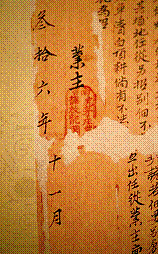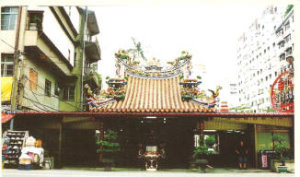Early Taoyuan Development History is composed of
following phases: 
(1)Hu-Mao-Chuang Village Period
(early period of rulingof Emperor Chien-Lung
-about between AD 1736-1750):
Historical records state that the earliest immigration’s land cultivation was at the 4th year of Emperor Yung-Cheng(1726)when Lan, Yung and Lan, Tsung established Han-Chinese land cultivation in Taoyuan. Hu-Mao-Chuang means「A land overgrown with weeds」and 「Twitch grass hurting people like Tiger」;Another saying is that 「Hu-Mao(Tiger Twitch Grass)」was the native tribe’s language. The exact range of the so-called 「Hu-Mao-Chuang」is within Kui-Lun-Ling (modern Kui-Shan) in the east, Kan-Tzu-Chiao (modern Nei-Li) in the west, Hsiao-Li (Pa-Te) in the south and Nan-Kan in the nort |
The seal of Hsueh, Chi-Lung on a covenant made in Ching Dynasty(Right Photo)
Hsueh, Chi-Lung formerly named Chang-Kui or Chi-Lung. For his biography, please see《Taoyuan City History Diary or 《Taoyuan County History Diary 》 |
(2)Tao-Tzu-Yuen-Chuang Period
(betwen the mid ruling of Emperor Chien-Lung until late ruling of
Emperor Chia-Ching about 1750 and 1820):
| In the 70 years after Hsuen, Chi-Lung started big-scale land cultivation in Hu-Mao-Chuang, Taoyuan had developed from a simple land-cultivation village into a city of a certain scale. It is said that immigrants planted peach trees (pronounced as Tao in Chinese), it is thus called 「Tao-Tzu-Yuan(peach garden)」。 |
The village developed mainly from 『Kai-Chi Groundkeeper God Temple』(intersection of Chung-Shan Road and Min-Sheng Road) along Chung-Shang Road westbound. As Taoyuan downtown streets were ever devastated by group mechanical fighting, clay walls were built in the 14th year of the ruling of Emperor Chia-Ching (1809)which was the start of modern Taoyuan City. |

Kai-Chi Groundkeeper God Temple Locate in the intersection of Chung-Shan Road and Min-Sheng Road。Please see《Taoyuan City History Diary 》 |
(3)Taoyuan City Period
(From early ruling of Emperor Tao-Kuang in Ching Dynasty to Japan
Colonial ruling ,about between 1820 and 1900)::
| At the 14th year in the ruling of Emperor Chia-Ching (1809), fellows from Chang Province 「built clay castle for defense」. At the 14th year of Tao-Kuang(1834), a very rich man Mr. Yao changed the clay wall into stone wall(which was dismantled in Japan colonial ruling). As the village became important increasingly, more Han-Chinese migrated into and the downtown streets developed outwards. 「Tao-Tzu-Yuan(peace tree garden)」and「Tao-Yuan」were both commonly called during the ruling of Emperor Kuang-Hsu. At the 14th year of Emperor Kuang-Hsu(1880), it was recorded as 「Taoyuan」in “Fish-Scale”Land Measurement Registry Volume in Ching Dynasty. In the 36th year of Japanese Emperor Meiji during Japan Colonial Ruling(AD 1903、29th year of Emperor Kuang-Hsu Ching Dynasty), it was formally named as「Taoyuan」. |
|